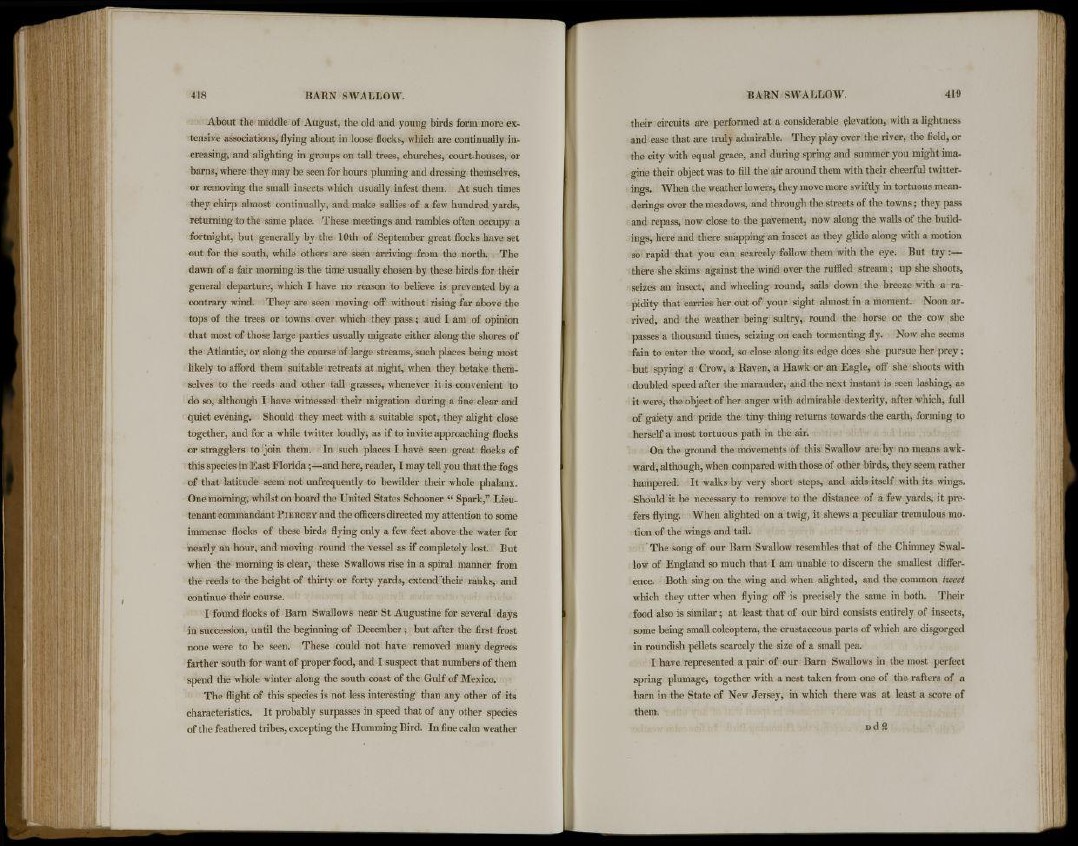
About the middle of August, the old and young birds form more extensive
associations, flying about in loose flocks, which are continually increasing,
and alighting in groups on tall trees, churches, court-houses, or
barns, where they may be seen for hours pluming and dressing themselves,
or removing the small insects which usually infest them. At such times
they chirp almost continually, and make sallies of a few hundred yards,
returning to the same place. These meetings and rambles often occupy a
fortnight, but generally by the 10th of September great flocks have set
out for the south, while others are seen arriving from the north. The
dawn of a fair morning is the time usually chosen by these birds for their
general departure, which I have no reason to believe is prevented by a
contrary wind. They are seen moving off without rising far above the
tops of the trees or towns over which they pass; aud I am of opinion
that most of those large parties usually migrate either along the shores of
the Atlantic, or along the course of large streams, such places being most
likely to afford them suitable retreats at night, when they betake themselves
to the reeds and other tall grasses, whenever it is convenient to
do so, although I have witnessed their migration during a fine clear and
quiet evening. Should they meet with a suitable spot, they alight close
together, and for a while twitter loudly, as if to invite approaching flocks
or stragglers to join them. In such places I have seen great flocks of
this species in East Florida;—and here, reader, I may tell you that the fogs
of that latitude seem not unfrequently to bewilder their whole phalanx.
One morning, whilst on board the United States Schooner " Spark," Lieutenant
commandant P I K R C E Y and the officers directed my attention to some
immense flocks of these birds flying only a few feet above the water for
nearly an hour, and moving round the vessel as if completely lost. But
when the morning is clear, these Swallows rise in a spiral manner from
the reeds to the height of thirty or forty yards, extend "their ranks, and
continue their course.
I found flocks of Barn Swallows near St Augustine for several days
in succession, until the beginning of December ; but after the first frost
none were to be seen. These could not have removed many degrees
farther south for want of proper food, and I suspect that numbers of them
spend the whole winter along the south coast of the Gulf of Mexico.
The flight of this species is not less interesting than any other of its
characteristics. It probably surpasses in speed that of any other species
of the feathered tribes, excepting the Humming Bird. In fine calm weather
their circuits are performed at a considerable elevation, with a lightness
and ease that are truly admirable. They play over the river, the field, or
the city with equal grace, and during spring and summer you might imagine
their object was to fill the air around them with their cheerful twitterings.
When the weather lowers, they move more swiftly in tortuous meanderings
over the meadows, and through the streets of the towns; they pass
and repass, now close to the pavement, now along the walls of the buildings,
here and there snapping an insect as they glide along with a motion
so rapid that you can scarcely follow them with the eye. But try :—
there she skims against the wind over the ruffled stream; up she shoots,
seizes an insect, and wheeling round, sails down the breeze with a rapidity
that carries her out of your sight almost in a moment. Noon arrived,
and the weather being sultry, round the horse or the cow she
passes a thousand times, seizing on each tormenting fly. Now she seems
fain to enter the wood, so close along its edge does she pursue her prey;
but spying a Crow, a Raven, a Hawk or an Eagle, off she shoots with
doubled speed after the marauder, and the next instant is seen lashing, as
it were, the object of her anger with admirable dexterity, after which, full
of gaiety and pride the tiny thing returns towards the earth, forming to
herself a most tortuous path in the air.
On the ground the movements of this Swallow are by no means awkward,
although, when compared with those of other birds, they seem rather
hampered. It walks by very short steps, and aids itself with its wings.
Should it be necessary to remove to the distance of a few yards, it prefers
flying. When alighted on a twig, it shews a peculiar tremulous motion
of the wings and tail.
The song of our Barn Swallow resembles that of the Chimney Swallow
of England so much that I am unable to discern the smallest difference.
Both sing on the wing and when alighted, and the common tweet
which they utter when flying off is precisely the same in both. Their
food also is similar; at least that of our bird consists entirely of insects,
some being small coleóptera, the crustaceous parts of which are disgorged
in roundish pellets scarcely the size of a small pea.
I have represented a pair of our Barn Swallows in the most perfect
spring plumage, together with a nest taken from one of the rafters of a
barn in the State of New Jersey, in which there was at least a score of
them.
DC! 2